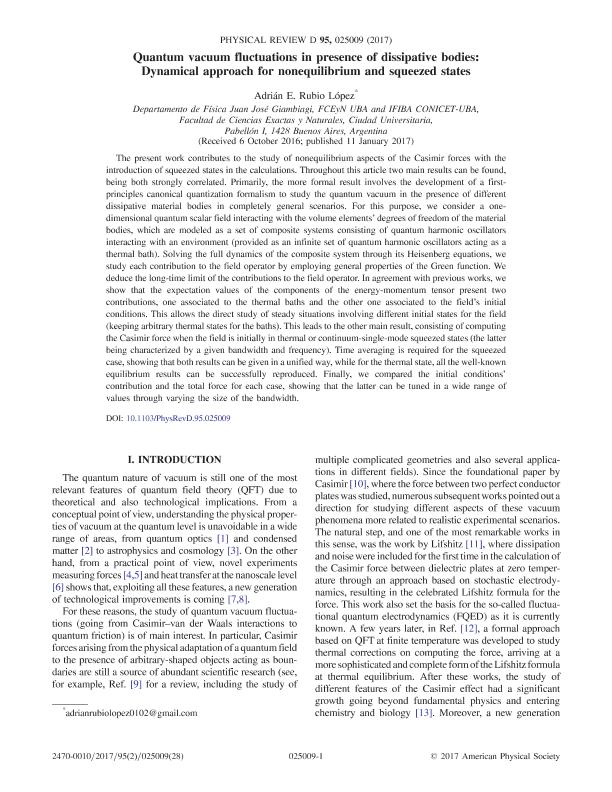Mostrar el registro sencillo del ítem
dc.contributor.author
Rubio Lopez, Adrian Ezequiel

dc.date.available
2018-06-19T17:00:27Z
dc.date.issued
2017-01
dc.identifier.citation
Rubio Lopez, Adrian Ezequiel; Quantum vacuum fluctuations in presence of dissipative bodies: Dynamical approach for nonequilibrium and squeezed states; American Physical Society; Physical Review D; 95; 2; 1-2017; 1-28
dc.identifier.issn
2470-0029
dc.identifier.uri
http://hdl.handle.net/11336/49308
dc.description.abstract
The present work contributes to the study of nonequilibrium aspects of the Casimir forces with the introduction of squeezed states in the calculations. Throughout this article two main results can be found, being both strongly correlated. Primarily, the more formal result involves the development of a first-principles canonical quantization formalism to study the quantum vacuum in the presence of different dissipative material bodies in completely general scenarios. For this purpose, we consider a one-dimensional quantum scalar field interacting with the volume elements' degrees of freedom of the material bodies, which are modeled as a set of composite systems consisting of quantum harmonic oscillators interacting with an environment (provided as an infinite set of quantum harmonic oscillators acting as a thermal bath). Solving the full dynamics of the composite system through its Heisenberg equations, we study each contribution to the field operator by employing general properties of the Green function. We deduce the long-time limit of the contributions to the field operator. In agreement with previous works, we show that the expectation values of the components of the energy-momentum tensor present two contributions, one associated to the thermal baths and the other one associated to the field's initial conditions. This allows the direct study of steady situations involving different initial states for the field (keeping arbitrary thermal states for the baths). This leads to the other main result, consisting of computing the Casimir force when the field is initially in thermal or continuum-single-mode squeezed states (the latter being characterized by a given bandwidth and frequency). Time averaging is required for the squeezed case, showing that both results can be given in a unified way, while for the thermal state, all the well-known equilibrium results can be successfully reproduced. Finally, we compared the initial conditions' contribution and the total force for each case, showing that the latter can be tuned in a wide range of values through varying the size of the bandwidth.
dc.format
application/pdf
dc.language.iso
eng
dc.publisher
American Physical Society

dc.rights
info:eu-repo/semantics/openAccess
dc.rights.uri
https://creativecommons.org/licenses/by-nc-sa/2.5/ar/
dc.subject
Casimir
dc.subject
Nonequilibrium
dc.subject
Canonical Quantization
dc.subject
Squeezed
dc.subject.classification
Astronomía

dc.subject.classification
Ciencias Físicas

dc.subject.classification
CIENCIAS NATURALES Y EXACTAS

dc.title
Quantum vacuum fluctuations in presence of dissipative bodies: Dynamical approach for nonequilibrium and squeezed states
dc.type
info:eu-repo/semantics/article
dc.type
info:ar-repo/semantics/artículo
dc.type
info:eu-repo/semantics/publishedVersion
dc.date.updated
2018-06-12T16:07:01Z
dc.journal.volume
95
dc.journal.number
2
dc.journal.pagination
1-28
dc.journal.pais
Estados Unidos

dc.journal.ciudad
Nueva York
dc.description.fil
Fil: Rubio Lopez, Adrian Ezequiel. Universidad de Buenos Aires. Facultad de Ciencias Exactas y Naturales. Departamento de Física; Argentina. Consejo Nacional de Investigaciones Científicas y Técnicas. Oficina de Coordinación Administrativa Ciudad Universitaria. Instituto de Física de Buenos Aires. Universidad de Buenos Aires. Facultad de Ciencias Exactas y Naturales. Instituto de Física de Buenos Aires; Argentina
dc.journal.title
Physical Review D

dc.relation.alternativeid
info:eu-repo/semantics/altIdentifier/url/https://link.aps.org/doi/10.1103/PhysRevD.95.025009
dc.relation.alternativeid
info:eu-repo/semantics/altIdentifier/doi/http://dx.doi.org/10.1103/PhysRevD.95.025009
Archivos asociados
